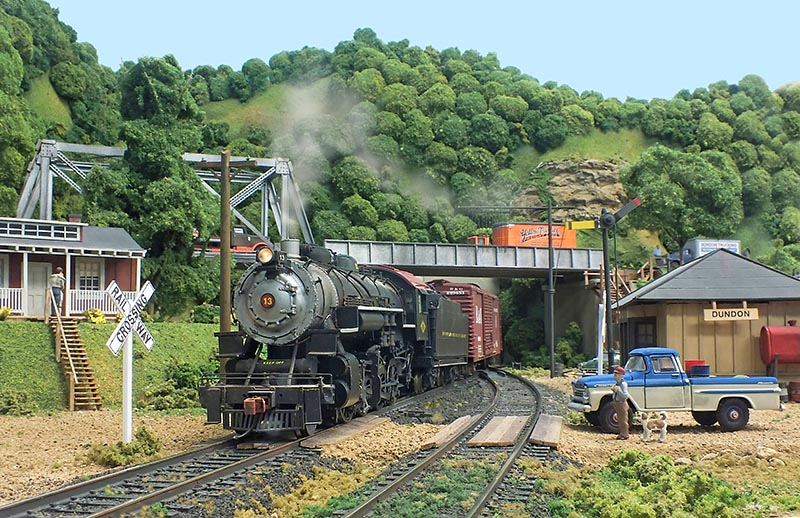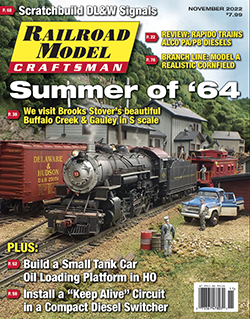 By Brooks Stover, MMR/photos by the author
By Brooks Stover, MMR/photos by the author
Founded in 1904, the Buffalo Creek & Gauley (BC&G) Railroad ran from an interchange with the Baltimore & Ohio at Dundon, in central West Virginia, to a large coal mine in Widen, a distance of just 18.6 miles. For nearly 50 years heavy coal trains rattled along the meandering right-of-way that followed the railroad’s namesake Buffalo Creek behind husky hand-me-down 2-8-0 Consolidations. The railroad was a fan favorite for operating steam into the 1960s, but in December 1963 the mine was no longer economically viable and it was closed on short notice. What was the railroad to do now?
The parent company of the railroad — the Elk River Coal & Lumber Co. (ERC&L) — also owned the coal mine, and a logging operation and a large sawmill at Swandale, exactly halfway between Dundon and Widen. So the Consolidations continued to run for a couple of years but now operated on just the nine miles of track between Dundon and Swandale. Consists were short, usually less than a half-dozen bulkhead flats and boxcars hauling finished lumber and chip hoppers filled with the leftovers from the sawmill.
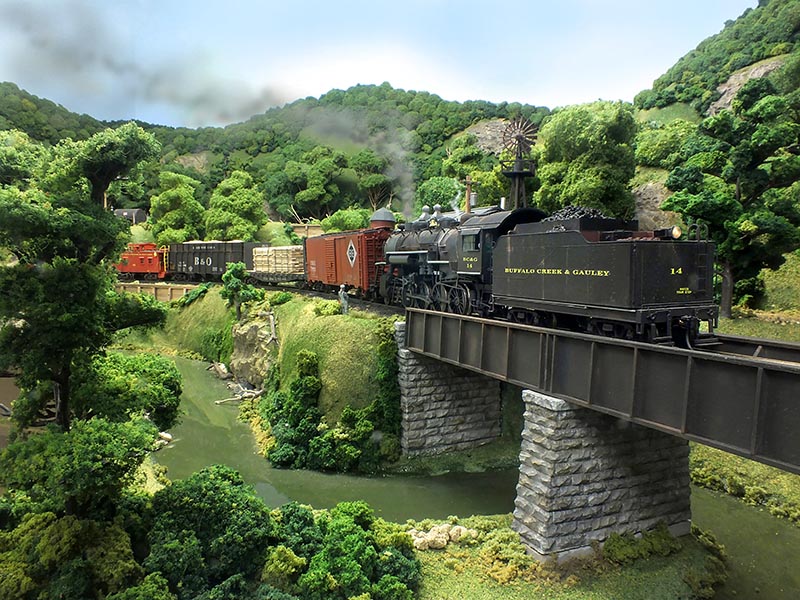
ABOVE: By taking the county road it’s possible to get good photos of trains on the bridge at Cressmont. This trip I caught 14 running tender-first on her way back to the interchange at Dundon. The consist was typical of all the trains these days: loads of finished lumber and wood chips. Caboose C-1 was a gift to Richard Manning, the railroad’s superintendent, from his friends at B&O. What a beautiful setting for a railroad!
The BC&G ran its final trip in 1965. Though a portion of the railroad was briefly revived by Majestic Mining in 1971, and again as the Elk River Railroad in the mid-1990s, the days of steam operation on the bucolic BC&G were gone for good.
I have been a fan of the BC&G for a long time. Its simple operations, scenic location, chunky steam power, and meandering track have given some to describe it as a standard gauge railroad with the character of a narrow gauge line. My current 12×25 foot S scale layout is the fourth I’ve built depicting the BC&G, representing the railroad during the summer of 1964. (See “Satisfying Operations on a Smaller Layout,” Railroad Model Craftsman, February 2021.) It was the final summer for steam, as in February 1965 the last Consolidation ran from Swandale to Dundon.
I never visited the real BC&G while it was in operation but I recently took a virtual railfan trip around my layout taking a series of photos from viewpoints not accessible while viewing the layout in person from the aisle. So while I missed the real thing, here through the magic of model railroading are some photos of three trips to the BC&G in the summer of 1964… the 1/64 version of the railroad in my basement, that is.
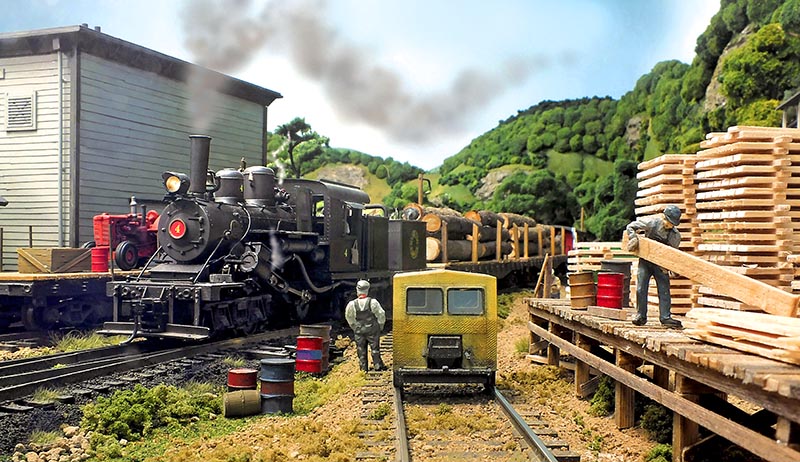
ABOVE: I hung around Swandale all day catching up with the workers I’d come to know over my many visits. Late in the afternoon, right on schedule, Climax 4 came back from the woods with a short string of loaded log cars. A BC&G work crew had moved their speeder onto to the siding where finished lumber is loaded to make way for the log train. Years later I got to ride a speeder along the entire length of the railroad with my good friends Frank Criswell and George Pierson.
Reality Check
I never visited the BC&G while it was in service although I could have if I’d known about it as I was a junior in high school in 1964. I did own that dark green ‘53 Chevy in 1964 and I did buy it for $100. Frank, George, and I did ride the entire length of the line on a speeder driven by Roger Nutter in 2007 although to do it we had to clear a lot of brush.
I have had the privilege of meeting in person, and/or corresponding with, a number of individuals who lived in the area or worked on the railroad. All of the persons named here were residents of the area or employees of the BC&G.
I have seen several of the BC&G surviving engines including Consolidation 4, now at Cass Scenic Railroad State Park in West Virginia, and, yes, Climax 3, now at Roaring Camp & Big Trees in Fulton, Calif. Both engines are disassembled and undergoing restoration. I had the thrill of riding in the cab of No. 4 when she was at the North Carolina Transportation Museum in the 1990s during a “BC&G Reunion” weekend which I helped organize.
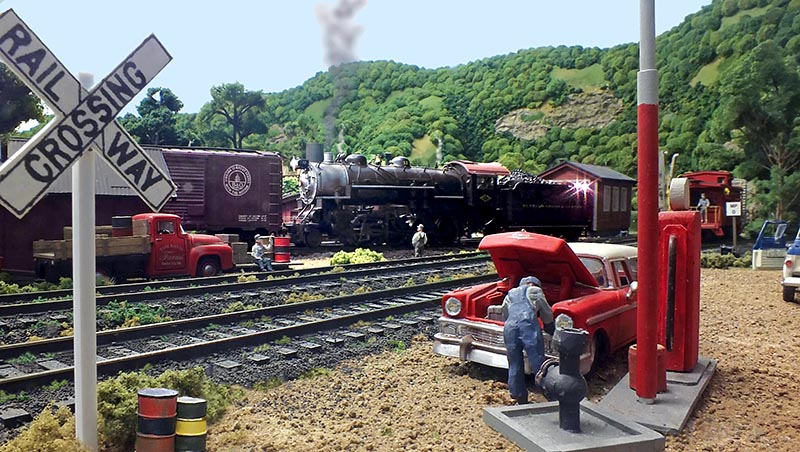
ABOVE:BC&G hostler Bobby Caruthers stopped to put some oil in his Chevy at the Esso pump in front of the store, while BC&G 13 switched cars on the coach track. Nearby, crews were working in the barn that houses the road’s Mack railbus.
All of the locomotives, structures and bridges, with the exception of the green yard office in Fig. 5, are modeled from prototype photos. The Union Pacific boxcar in Fig. 5, UP 163764, is a model of the only UP boxcar I’ve seen in any of the hundreds of BC&G photos I have.
Finally, I have collected a number of items of mememorabilia from the railroad which are displayed in my layout room and help bring the history of the BC&G to life. These include the Climax 3 builder’s plate, conductor’s orders and other paperwork, pieces of ERC&L scrip, a BC&G kerosene lantern, a candlestick phone from the yard office, and BC&G switch locks and keys…


